Health Insurance
Gen Zers Nearly 3 Times More Likely Than Older Generations To Seek Therapy Since Start of Pandemic

The COVID-19 pandemic brought unprecedented challenges, many of which still linger. Though the shutdowns and social distancing are largely a thing of the past, many consumers may still feel the emotional toll — and some may be more willing to seek professional help than before.
According to the latest ValuePenguin survey of more than 2,000 U.S. consumers, 72% of Americans who’ve seen a therapist since March 2020 sought therapy after the start of the global crisis. Additionally, 56% who’ve sought therapy in this period say the crisis caused them to be more willing to seek mental health help than in the past.
Keep reading to learn which groups are more likely to seek therapy and what barriers may prevent others from doing the same.
On this page
- Key findings
- COVID-19 may have sparked a rise in therapy
- Majority of Americans haven’t seen a therapist and aren’t considering it
- Americans who went to therapy cite anxiety/stress, feeling overwhelmed as top reasons for going
- 68% of recent patients say virtual therapy has helped accessibility
- Financial limitations are a barrier for many would-be patients
- Looking for cost-effective options? Here’s what experts recommend
- Methodology
Key findings
- The coronavirus pandemic’s impact on the world was unprecedented, which could be why 72% of Americans who’ve seen a therapist since March 2020 sought therapy after the start of the global crisis. 69% of Americans who've had recent mental health counseling say their therapist helped them cope with the pandemic, while 56% say the crisis caused them to be more willing to seek help than in the past.
- Despite an increase in the demand for mental health services, the majority (55%) of Americans say they haven’t seen a therapist since the pandemic began and aren’t considering it. Older generations are incrementally more likely to pass on therapy (and not consider it) since the start of the pandemic. Baby boomers are 59% less likely to seek it than Gen Zers — 81% versus 33%.
- Although not the primary reason for seeking counseling, Americans relied on mental health resources to cope with COVID-19’s impact on everyday life. Only 7% say the main reason for wanting mental health services was due to the pandemic, although the crisis may have activated dormant issues. The top reasons cited for seeking therapy during this period were anxiety and stress related to personal relationships (12%) and feeling overwhelmed and needing someone to talk to (11%).
-
Apps like Talkspace and BetterHelp are making therapy more accessible, as 68% of recent patients say virtual therapy has allowed them to seek help when they otherwise wouldn’t have had the time or resources to meet in person. Of the 23% of people considering counseling, 45% agree that digital access positively impacts their ability to seek care.
- Access to therapy isn’t what’s holding back the majority of people. 60% of those who haven't seen someone recently say they don’t need it, but financial limitations are still a barrier for many. 15% say they can’t afford the copays, even though 76% of recent patients say their health insurance covers the cost of therapy (copay aside). Gen Zers (22%), those who’ve never been married (19%) and women (17%) are among the most likely to say their therapy copays make treatment unattainable.
COVID-19 may have sparked a rise in therapy
Given how the COVID-19 pandemic affected most consumers, it’s unsurprising that 72% of Americans who’ve seen a therapist since March 2020 sought therapy after the global crisis began. Of those who’ve recently sought mental health, 69% say their therapist helped them cope with the pandemic.
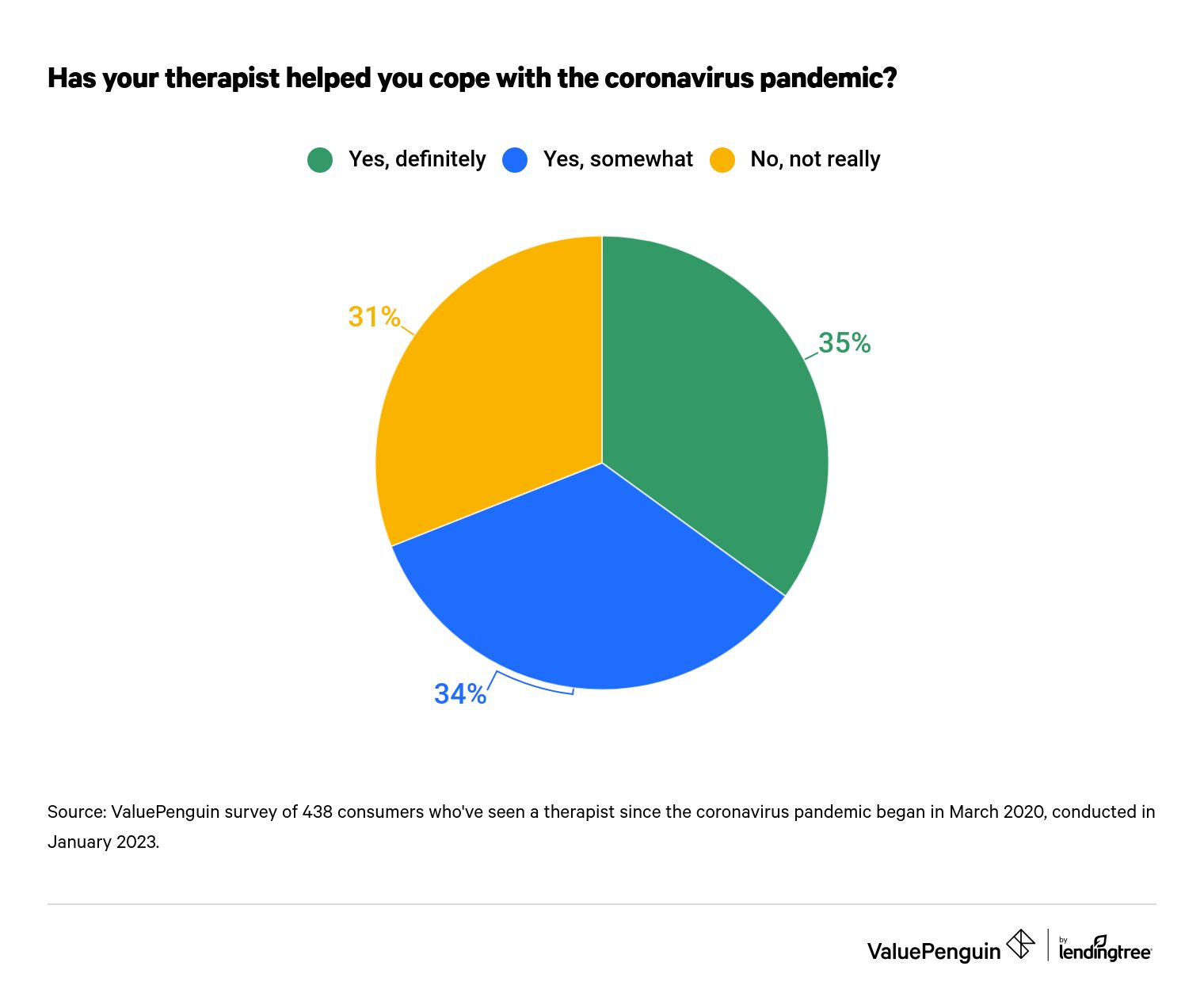
Millennials ages 27 to 42 (75%) and Gen Zers ages 18 to 26 (74%) are the most likely age groups to say their therapist helped them cope during the pandemic, while Gen Xers ages 43 to 58 (59%) and baby boomers ages 59 to 77 (63%) are the least likely.
Meanwhile, 56% of those who’ve seen a therapist since March 2020 say the crisis caused them to be more willing to seek help than in the past.
Majority of Americans haven’t seen a therapist and aren’t considering it
Despite an increase in the demand for mental health services, 55% of Americans say they haven’t sought therapy since March 2020 and aren’t thinking about it. Baby boomers (81%) and Americans with adult children (72%) are most likely to say they’re not considering seeing a therapist.
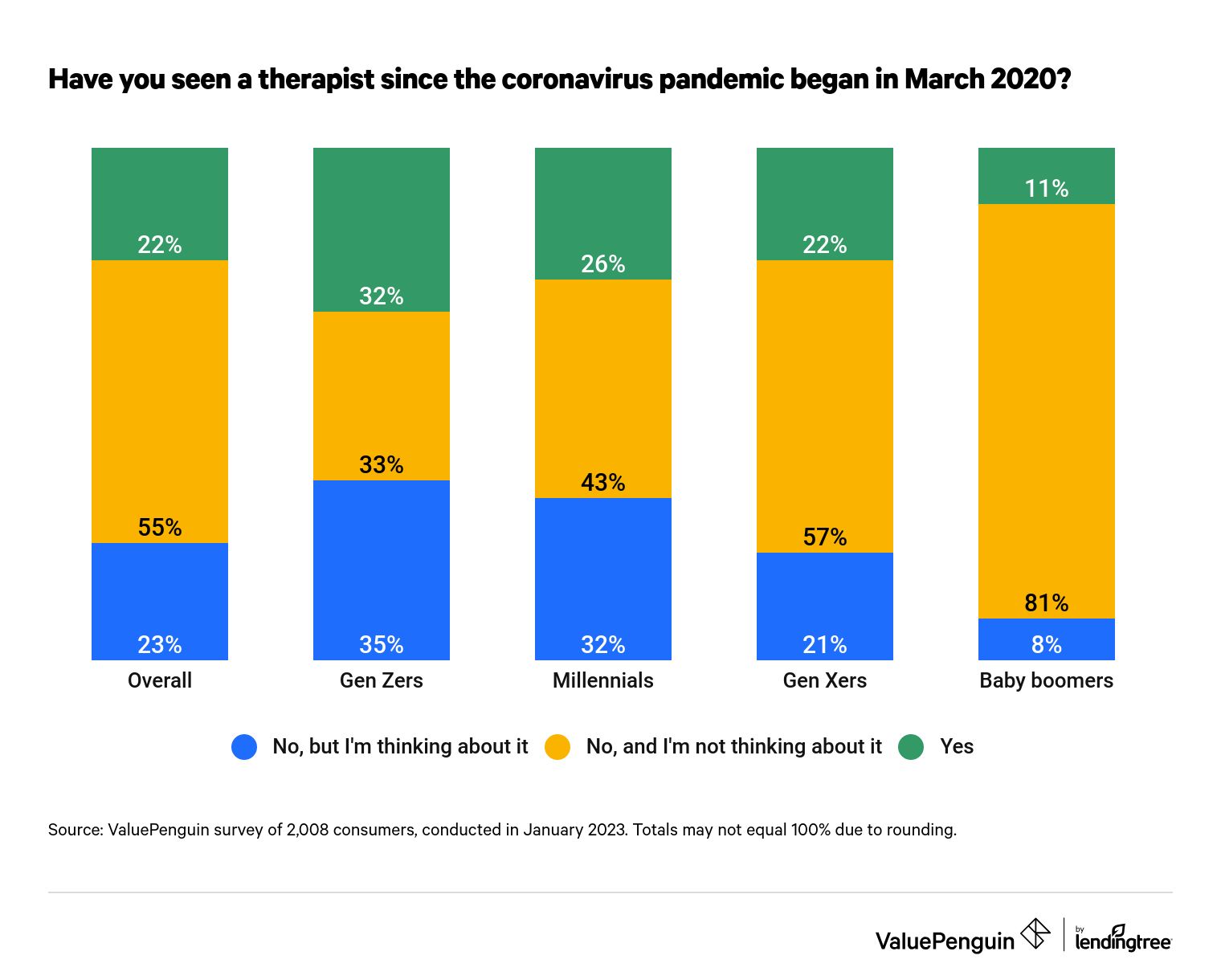
There are a few reasons why these consumers may have an aversion to seeking mental health care, but it largely boils down to personal barriers. Of those who aren’t considering therapy, 10% say they don’t have enough time to see a therapist and 7% are worried they’d be judged by their loved ones for doing so.
But who has sought therapy — and how do they stack up against those who haven’t? Across all consumers surveyed, 22% say they’ve seen a therapist at least once since March 2020. The groups most likely to have done so are:
- Gen Zers (32%)
- People with children younger than 18 (28%)
- Women (26%)
- Millennials (26%)
- Six-figure earners (25%)
More than 8 in 10 baby boomers (81%) say they haven’t seen a therapist and aren’t thinking about it, versus 33% of Gen Zers. Looking at the data differently, 32% of Gen Zers have seen a therapist since the pandemic began — nearly three times higher than baby boomers (11%).
According to ValuePenguin health insurance expert Divya Sangameshwar, there are a few reasons why older generations may be more adverse to therapy.
"As a generation, baby boomers grew up with tremendous stigma around mental health care and saw seeking treatment for mental illness as a moral failure instead of a health problem," she says. "Many mental health issues were still being researched when baby boomers were growing up. There was little education available about mental health or how to discuss mental health issues, and derogatory labels were often used to describe mental health struggles, adding to the stigma and shame associated with seeking help."
Meanwhile, just under a quarter (23%) of Americans say they haven’t seen a therapist, but they’re thinking about doing so. Younger consumers are once again the most therapy-positive, with Gen Zers (35%) and millennials (32%) the most likely to say they’re considering mental care. Following that, the most likely groups to say they’re considering therapy include:
- People who’ve never been married (31%)
- People with no children (27%)
- People making less than $35,000 annually (26%)
- People with children younger than 18 (26%)
- Women (25%)
Americans who went to therapy cite anxiety/stress, feeling overwhelmed as top reasons for going
More than a quarter (28%) of Americans who’ve seen a therapist during the pandemic were already in therapy before the global crisis. However, while only 7% of recent therapy patients say the main reason for wanting mental health services was due to the pandemic, the crisis may have activated dormant issues.
In fact, with social isolation at an all-time high during the lockdowns, 12% say they sought help for anxiety and stress related to their personal relationships, making it the top reason for seeking therapy. Not far behind that, 11% say they felt overwhelmed and needed someone to talk to, while 10% say they sought help for other unspecified issues.
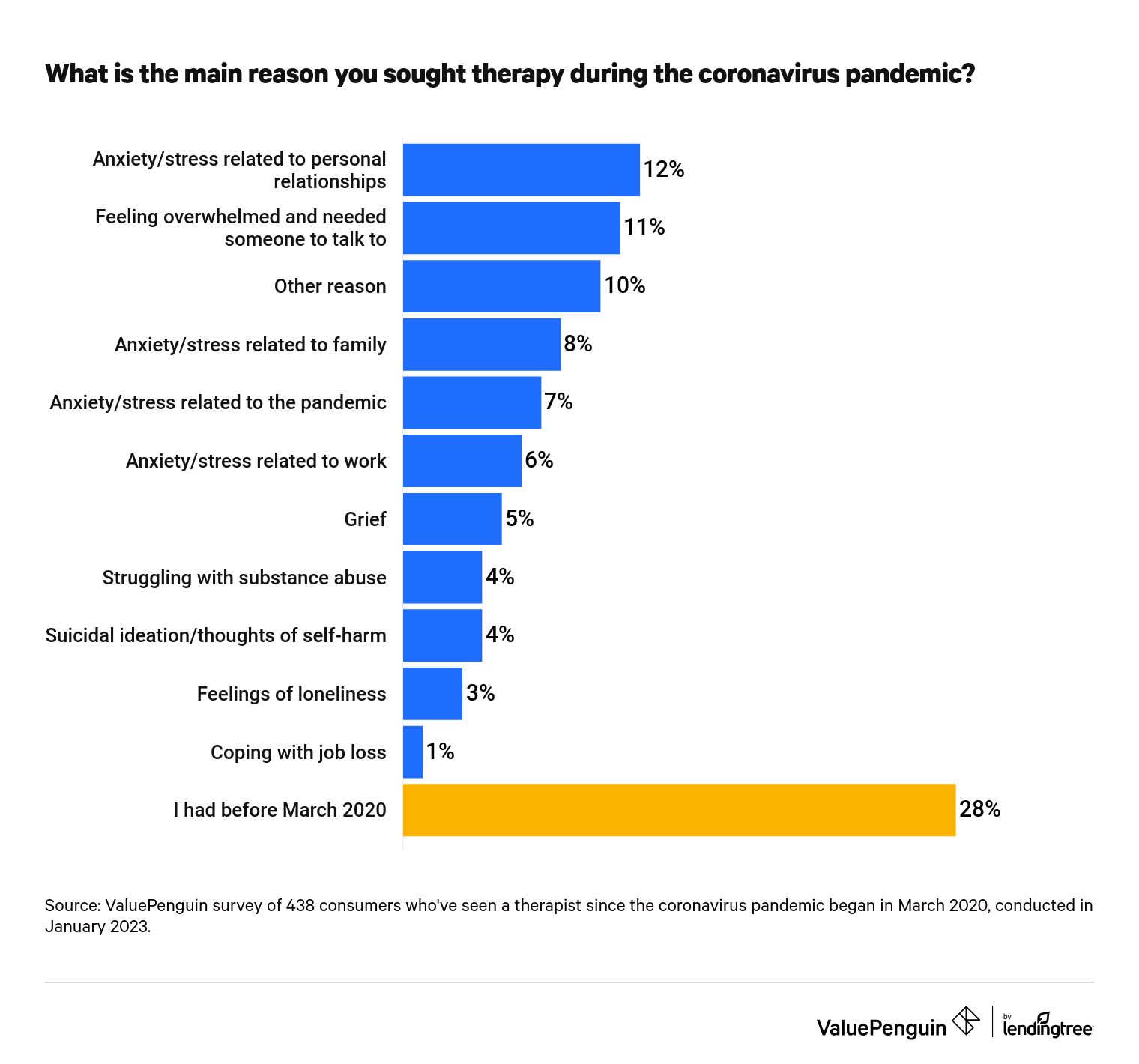
Americans also sought therapy to handle major mental health struggles. That includes:
- Grief (5%)
- Substance abuse (4%)
- Thoughts of self-harm and suicide (4%)
- Loneliness (3%)
Although men (17%) are less likely to have seen a therapist since the pandemic began than women (26%), both genders sought therapists for similar reasons. Among their top two reasons for seeking help, both genders wrestled with anxiety or stress related to personal relationships and feeling overwhelmed and needing someone to talk to. However, men are almost twice as likely to cite work stress (9% versus 5%) and women are more than three times as likely to cite anxiety or stress related to family (10% versus 3%) as reasons for seeing a therapist.
68% of recent patients say virtual therapy has helped accessibility
Zoom isn’t the only app that exploded in popularity during the height of lockdowns. Many consumers also turned to online therapy through apps like Talkspace and BetterHelp to make therapy more accessible. In fact, 68% of recent patients say virtual therapy has allowed them to seek help when they otherwise wouldn’t have had the time or resources to meet in person. Similarly, of the 23% of people considering therapy, a little less than half (45%) agree that digital access positively impacts their ability to seek care.
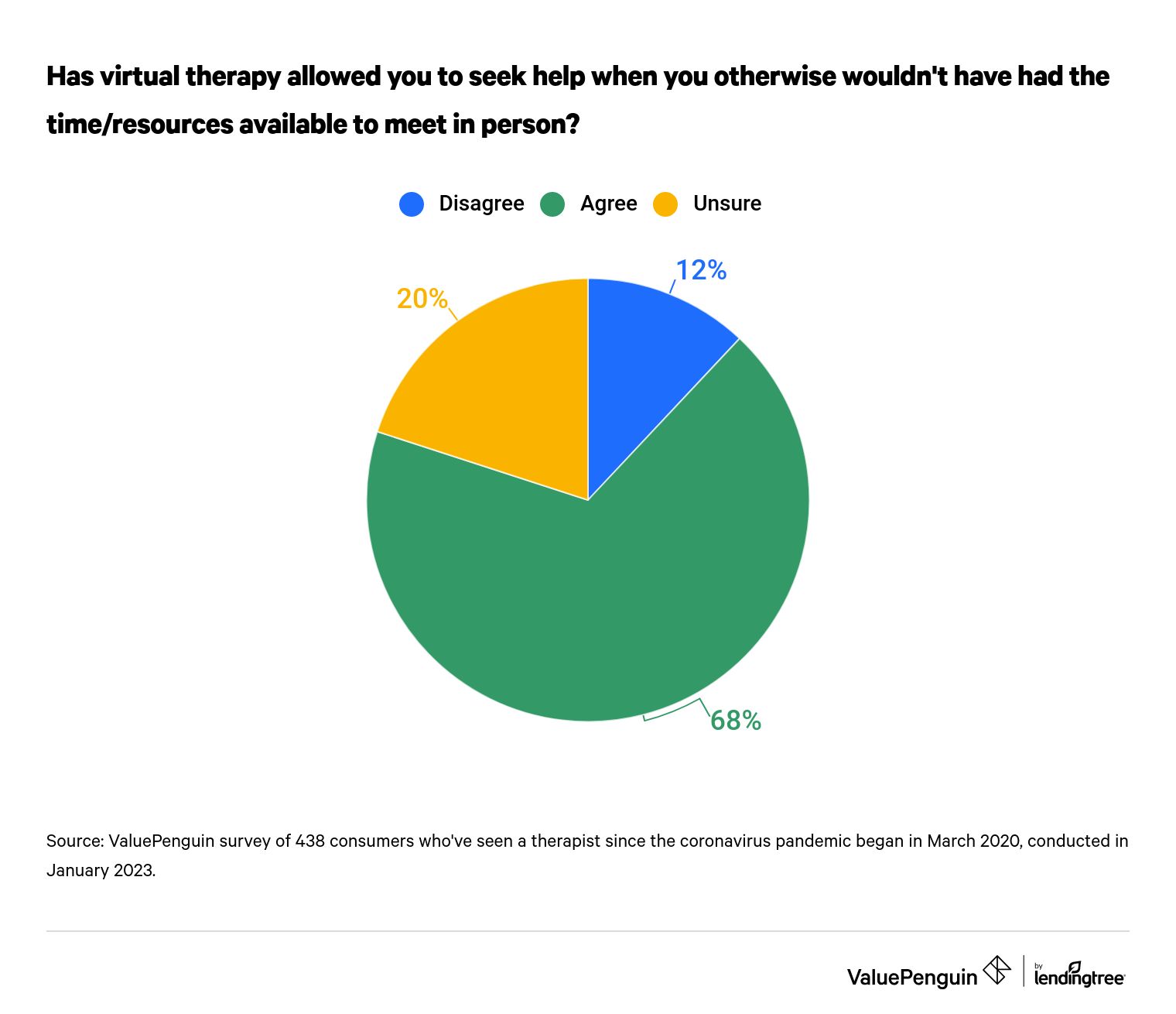
While there are a lot of pros to app-based therapy, Sangameshwar says users should still be cautious when exploring their options.
"Therapy and mental health care apps offer convenience, anonymity and lower costs, which is especially true for Americans who hesitate to seek help due to shame, stigma, anxiety or financial concerns," she says. "That said, as app-based therapy and mental health care is new, there isn’t a lot of research on its effectiveness. There also aren’t industrywide standards for treatment on mental health care apps. Finally, there are wider concerns that if an app or program overpromises, sick Americans may turn away from traditional therapy and mental health care."
In-person therapy continues to be popular, though. Of those in therapy recently, 47% mostly go to in-person appointments, though virtual therapist appointments over video are almost on par (41%). Meanwhile, a phone call is the least popular way to see a therapist, as only 12% say they’ve mostly attended phone call therapy sessions.
Who prefers in-person therapy? Men (53%) say they’d rather go the traditional route, while women (46%) prefer video visits.
Despite how they attend their therapy appointments, Americans generally prefer to stay close to home. Of those who’ve recently gone to therapy, 77% see a therapist local to their area.
Financial limitations are a barrier for many would-be patients
Although 60% of those who haven't seen a therapist recently say they don’t need it, financial limitations are still a barrier for many. In fact, 15% say they haven’t seen a therapist because they can’t afford the copays, even though 76% of recent patients say their insurance covers the cost of therapy outside of the copay.
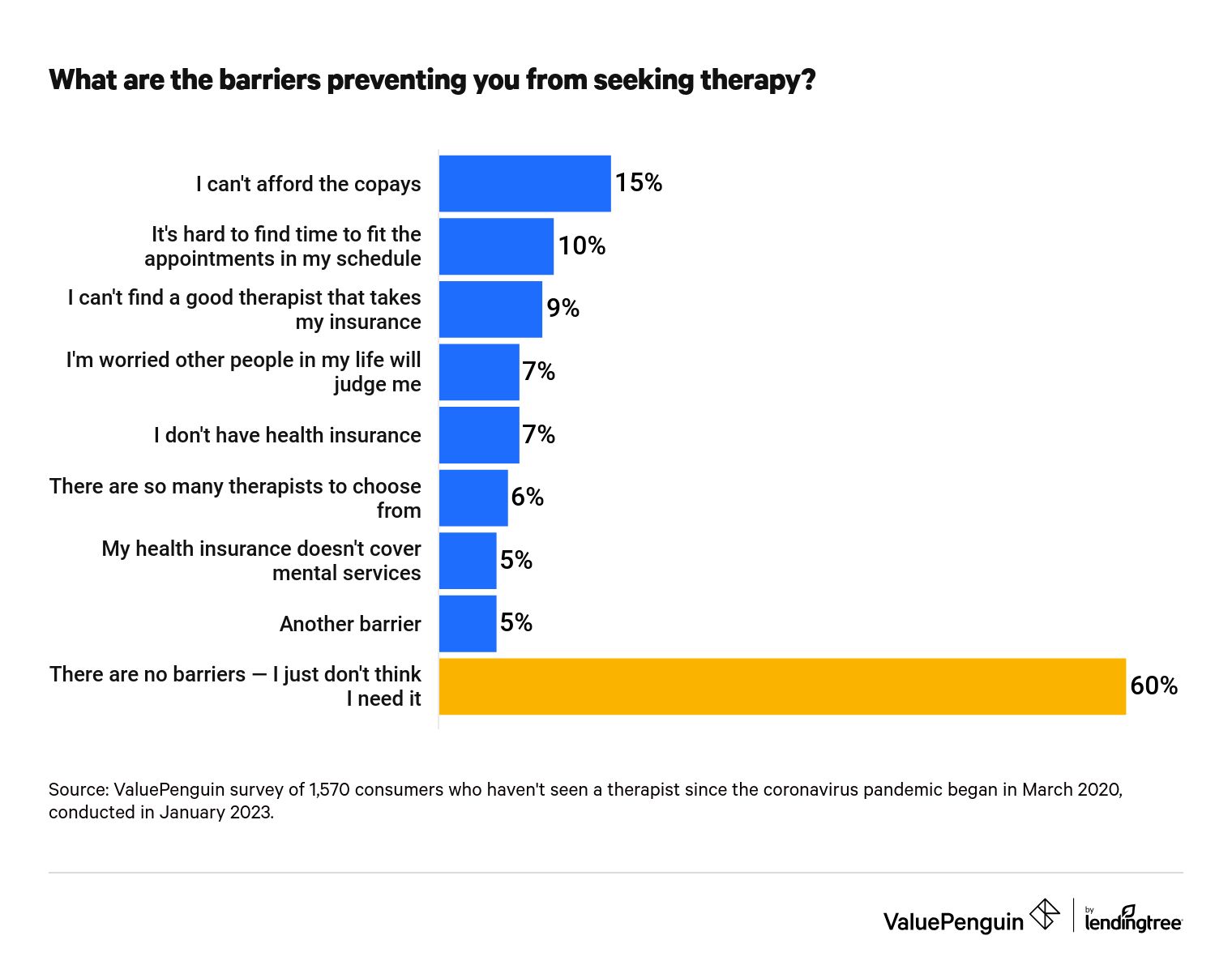
That’s not all — many consumers struggle with insurance coverage when looking for a therapist. Specifically, 9% can't find a good therapist that takes their insurance and 5% say their health insurance doesn’t cover mental health services. Meanwhile, 7% say their biggest barrier to seeking mental health was that they didn’t have health insurance.
It’s also worth noting that 40% of respondent say their employers don’t offer therapy resources to employees. Among those whose employers provide therapy resources, 26% say their employer offers in-person or virtual counseling to employees and 9% offer help covering therapy costs.
Looking for cost-effective options? Here’s what experts recommend
If you’re struggling with mental health, it’s important to remember that mental health care doesn’t have to be a luxury. For those looking for cost-effective options, Sangameshwar offers the following tips:
- If you have private health insurance or insurance through your employer, talk to your provider about their network of therapists and mental health care facilities. "If you feel comfortable with online telehealth therapy, you should also ask if they’re in your insurer’s network, as the copays for telehealth therapy sessions tend to be lower than in-person sessions," she says. "If you want to use app-based therapy, it’s important to talk to your health care provider about its effectiveness for your condition and to your health insurer about whether the cost of app-based care is covered."
- If you’re on Medicaid, therapy should be covered by up to 30 sessions a year. "You can look up how much it’ll cost you on your Summary of Benefits and Coverage (SBC) document, which includes copayment or coinsurance rates per service type," Sangameshwar says. "Look for ‘outpatient mental health services’ in the list to determine how much your plan covers — and how much you’ll have to pay out of pocket, if anything. If you can’t find this information, call the customer service number on your Medicaid card."
- If you’re uninsured, ask your therapist about sliding-scale payment options. "While you’ll have to pay for your sessions out of pocket, sliding-scale payments use your income to determine the cost of your sessions," she says. "You can also contact your state’s department of public health and ask about local community-based clinics near you that offer free or low-cost mental health services. Nonprofits like the National Alliance on Mental Illness and Mental Health America can also connect you with low-cost or free mental health facilities. Finally, contact your nearest university hospital or medical school. Many of them have programs that give you access to therapists in training for free or at a low cost."
Methodology
LendingTree commissioned Qualtrics to conduct an online survey of 2,008 U.S. consumers ages 18 to 77 from Jan. 19 to 23, 2023. The survey was administered using a nonprobability-based sample, and quotas were used to ensure the sample base represented the overall population. Researchers reviewed all responses for quality control.
We defined generations as the following ages in 2023:
- Generation Z: 18 to 26
- Millennial: 27 to 42
- Generation X: 43 to 58
- Baby boomer: 59 to 77
